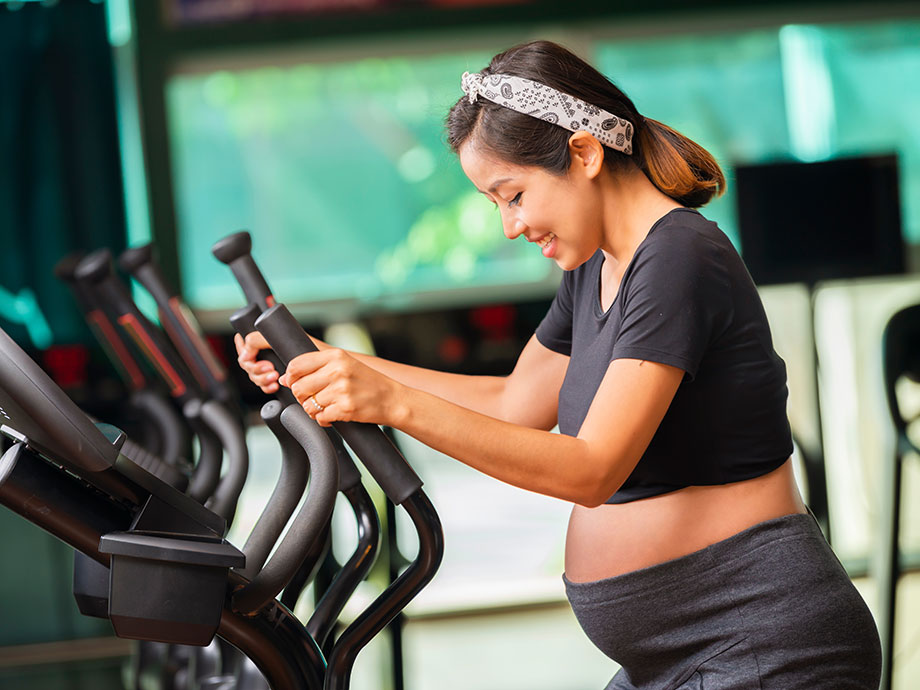We test and review fitness products based on an independent, multi-point methodology. If you use our links to purchase something, we may earn a commission. Read our disclosures.
Pregnancy doesn’t, and shouldn’t, sideline your exercise routine. However, you might need low-impact alternatives, like an elliptical, to reduce the stress on your body as your baby grows.
As much as morning sickness and a body that changes almost daily might make you want to skip working out, exercising during pregnancy is an important part of taking care of yourself and your baby. Hopping (or gently stepping) onto the elliptical during pregnancy is a low-impact cardio exercise that can help you manage weight gain and maintain cardiovascular fitness to the benefit of both you and your baby.
What Is An Elliptical?
An elliptical, aka an elliptical trainer, elliptical machine, or cross-trainer, is a machine that mimics the movement of running or walking (and to an extent climbing stairs) but with a low-impact gliding motion. These machines are primarily for cardio rather than muscle building. They have two large foot pedals connected to a flywheel and often have handlebars that move in tandem with the foot pedals.
RELATED: Does the Elliptical Build Glutes?
Ellipticals usually have a few levels of adjustable resistance, with some having adjustable foot pedal positions and heights. Your feet stay in constant contact with the foot pedals. You can choose whether or not to use the handlebars to activate the upper body for a full-body workout.
Are Ellipticals Safe During Pregnancy?
According to the American College of Obstetricians and Gynecologists (ACOG)1, “Physical activity and exercise in pregnancy are associated with minimal risks and have been shown to benefit most women, although some modification to exercise routines may be necessary…” ACOG adds their stamp of approval to the U.S. Department of Health and Human Services2 Physical Activity Guidelines for Americans, which recommend at least 150 minutes of moderate-intensity activity per week during pregnancy and postpartum.
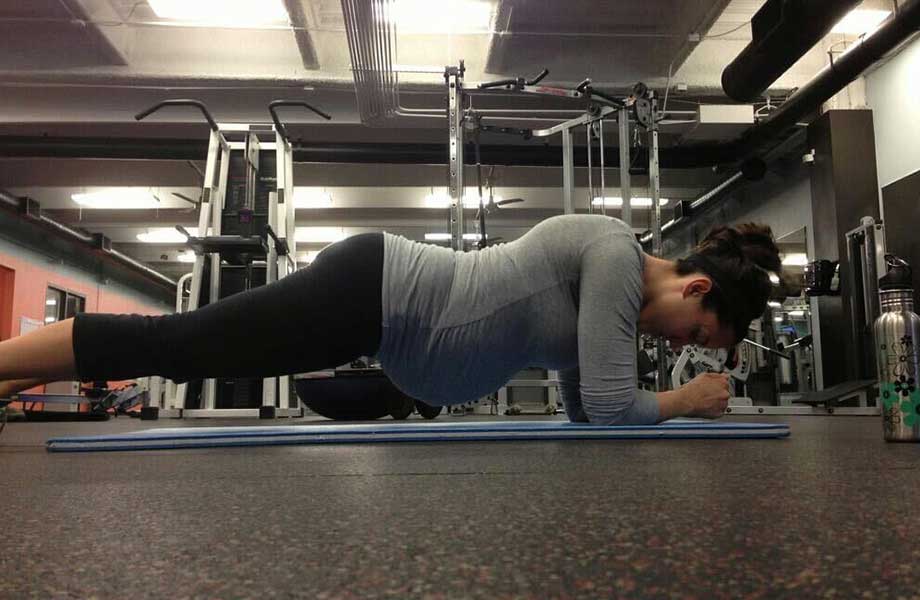
Ellipticals are considered safe during pregnancy, according to a 2012 literature review3 published in Research Quarterly for Exercise and Sport. The review found evidence that elliptical use is a good option when replacing more vigorous physical activity with more moderate and low-impact exercise. Ellipticals reduce joint stress4 and offer a number of ways to adjust the intensity so that as pregnancy progresses, you can modify workouts and safely exercise.
Pregnancy and how it affects the body is a very varied and personal experience. Consequently, you should talk to your doctor before starting an exercise routine. Some people can continue their current exercise programs with little modification up to the point of delivery. Others may experience discomfort, pain, or changes in their blood pressure or heart rate unless they tone down or modify their physical activity.
The Benefits of Elliptical Training During Pregnancy
Aerobic or cardio workouts provide many health benefits during pregnancy. Ellipticals offer those benefits in a low-impact, easy-to-adjust format.
Reduces Excessive Gestational Weight Gain
Weight gain is normal and healthy during pregnancy. However, excessive weight gain can increase the chances of developing pregnancy-induced high blood pressure (hypertension), greater infant size at birth, and cesarean delivery, according to a 2013 study5 published in PLOS ONE. Plus, the effects of excess weight gain aren’t over at birth, and they can affect both parent and baby.
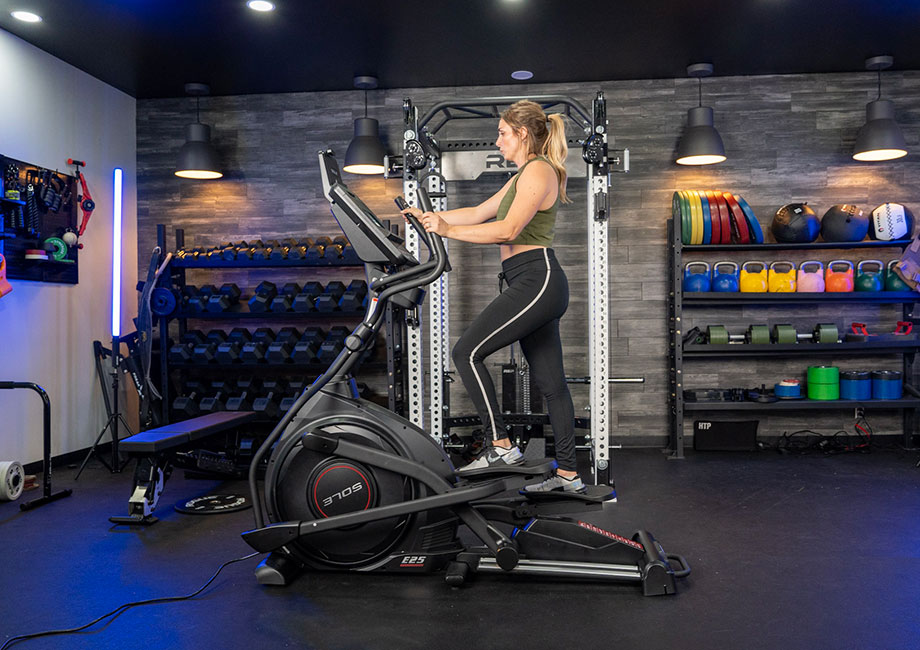
A 2012 cohort study6 conducted among 6,959 mothers and their children found that the children of mothers who gained excessive weight during pregnancy were at greater risk for being overweight in childhood. Regular exercise on an elliptical or other form of moderate-intensity exercise can help moderate weight gain to help you stay within a healthy range. However, consult a doctor about what healthy weight gain looks like for you.
Decreases Chances of Gestational Diabetes
The same 2012 cohort study also found that excessive weight gain, particularly during the first trimester of pregnancy, may contribute to a higher risk of gestational diabetes. Gestational diabetes occurs when you don’t have enough insulin to process sugar into energy. The Centers for Disease Control and Prevention7 recommends physical activity, which can come in the form of an elliptical workout, as a preventative measure against developing this type of diabetes.
RELATED: Elliptical Workouts for Runners
Reduces Risk of Preterm Birth
A 2016 study8 conducted among average-weight women found, among other benefits, that regular exercise reduces the chances of preterm birth. The reasons for this connection between exercise and preterm birth vary, but many of them are related to the health benefits of exercise already mentioned. Namely, gestational diabetes, high blood pressure, and excess weight gain can contribute to an increased risk of preterm birth. Exercise can help prevent those conditions and put parent and baby on track for a safe, healthy delivery.
Increased Chances of Safe Delivery
The previously mentioned 2016 study and a 2017 randomized control trial9 published in the American Journal of Obstetrics and Gynecology found that women who regularly exercise during pregnancy are less likely to have Cesarean sections (C-sections). All of the previously mentioned conditions—hypertension, gestational diabetes, and excess weight gain—increase the chances of C-sections. Regular exercise can give you better chances of lower-risk delivery.
Better Mental Health
Pregnancy-related hormonal and physical changes can take a toll on your mental health. While pregnancy is a joyous time, it can also be stressful. Much of the research on exercise and mental health has been done on people who aren’t pregnant.
For example, a 2021 review published in the Annual Review of Medicine10 found strong evidence of the positive benefits of exercise and the treatment of depression and anxiety. Another 2021 review11 found evidence that 10% to 30% of pregnant women experience depressive symptoms, with 17% reporting postpartum depression. In both studies, the findings suggested regular exercise can reduce symptoms of depression and anxiety.
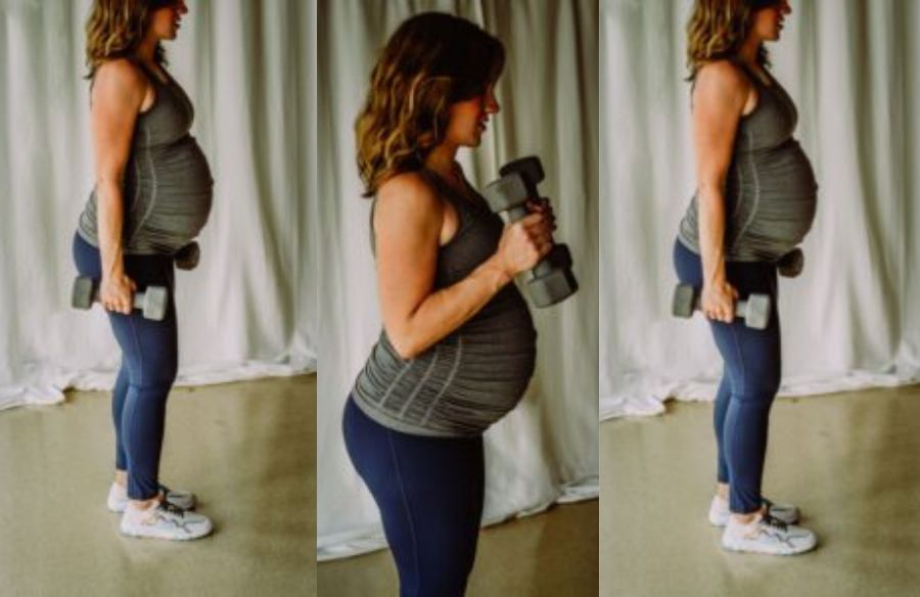
Tips for Elliptical Workouts
Low-impact elliptical workouts can be adapted based on your current physical fitness. If you want to shake things up, you can change resistance or pedal height in short intervals (30 seconds to 2 minutes) but keep yourself in a moderate-intensity range. Here are a few tips you can use to safely keep yourself fit:
- Warm up: Don’t hit the elliptical at full intensity from the get-go. Start at a low intensity for 5 minutes before raising your heart rate into moderate-intensity territory.
- Do a talk test: At a moderate intensity, you should be able to carry on a conversation but not sing. Periodically, do a talk test. If you’re huffing and puffing, you probably need to slow down or decrease the resistance. If you can warble a few verses of your workout playlist, you might need to push a little harder.
- Gradually add intensity or time (not both): If you haven’t been working out regularly, slowly work your way up to a moderate-intensity pace. However, only focus on adding either time or intensity (not both) in a single session. If you’re stretching yourself to get to 30 minutes, keep your workout fairly low-intensity until you can do 30 minutes several days in a row. If you’re already at 30 minutes but you’re trying to increase the time spent at a moderate intensity, add 1-minute or 2-minute moderate-intensity intervals with a couple of minutes at a lower intensity until you hit your 30-minute goal.
- Maintain stability: Your center of gravity shifts throughout pregnancy. Mount and dismount the elliptical carefully, so you don’t become unstable and fall. Hold onto the moving or stationary handlebars during your workout. Wait for the pedals to completely stop moving before exiting the machine.
- Adjust your workouts to your changing body: You’ll probably need to slow down or lower the resistance as your pregnancy progresses. What was a low-intensity resistance or speed during your first trimester may become your moderate-intensity resistance or speed in your third trimester.
- Be aware of your body: If you feel lightheaded or you start to have uterine contractions, slowly stop the elliptical and carefully get off.
- Stay hydrated: Sip water before, during, and after your workout to stay well hydrated.
- Dress appropriately: It’s easy to overheat when pregnant, so dress appropriately for the weather and room temperature. You may also need a more supportive sports bra and/or a belly band for added abdomen support.
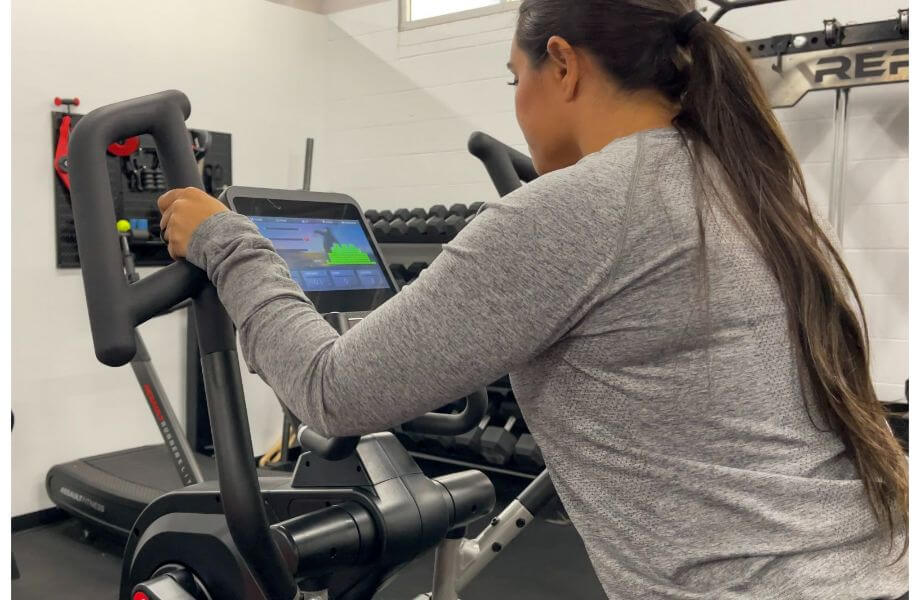
Elliptical During Pregnancy: Final Thoughts
Regular aerobic exercise creates a healthy foundation for you and your baby during and after pregnancy. These low-impact machines can help you reach the recommended 150 minutes of moderate-intensity exercise per week. Be careful when getting on, listen to your body, and adjust your workouts to your ever-changing body.
- You can break up your 150 minutes of moderate-intensity exercise any way you want. However, five 30-minute sessions are a good starting point.
- At a moderate intensity, you should be able to talk but not sing.
- Your center of gravity can change almost daily when pregnant. To maintain your balance, be careful when entering and exiting an elliptical.
- As your pregnancy progresses, you may need to dial down the resistance or pedal angle to prevent putting too much stress on your body.
- Talk to your health care provider before starting any exercise program.
Elliptical During Pregnancy: FAQs
Is it safe to do the elliptical while pregnant?
It is safe to do the elliptical while pregnant. However, talk to your doctor before using one, and be ready to adapt your workouts to fit the changing needs of your growing body. As with any type of workout, if you feel lightheaded, cramping, or uterine contractions, stop the exercise.
What cardio machines are safe during pregnancy?
Many cardio machines, including treadmills, exercise bikes, and ellipticals, are safe during pregnancy. A majority of people can safely use the same cardio machines during pregnancy that they used prepregnancy. But talk to your doctor and pay attention to how you feel during and after exercise. If you notice excess fatigue or discomfort, you might need to adjust your workout or switch to a machine that’s gentler on your body. Avoid any machine that puts stress on your lower back or abdomen.
When should you stop exercising when pregnant?
Many people can safely exercise for the duration of their pregnancy, though they may have to adapt their routine. Others may slow down their exercise routines as pregnancy progresses due to comfort issues or fatigue. In some cases, a doctor may prescribe lower activity or bed rest for the health of both you and your baby. Talk to your doctor and follow their recommendations based on your health history.
What workouts are safe during pregnancy?
Walking, swimming, elliptical, and using an exercise bike are a few exercises/workouts that are safe during pregnancy. Keep in mind that balance can become an issue later in pregnancy. As you progress into the third trimester be careful getting on or off an exercise bike or elliptical. In general, you can do any exercise that feels comfortable to you. Avoid workouts such as hot yoga or high-impact, contact sports that put you at risk for overheating or physical injury.
References
- Physical activity and exercise during pregnancy and the postpartum period. ACOG Committee Opinion No. 804. American College of Obstetricians and Gynecologists. Obstet Gynecol (2020). 135: e178–88.
- Physical activity current guidelines. U.S. Department of Health and Human Services. (2021).
- Downs, D. S., Chasan-Taber, L., Evenson, K. R., Leiferman, J., & Yeo, S. (2012). Physical Activity and Pregnancy: Past and Present Evidence and Future Recommendations. Research Quarterly for Exercise and Sport, 83(4), 485. https://doi.org/10.1080/02701367.2012.10599138
- Bosch, A.N., et al. (2021). Physiological and metabolic responses to exercise on treadmill, elliptical trainer, and stepper: Practical implications for training. International Journal of Sport Nutrition and Exercise Metabolism, 31(2), 135-142. https://doi.org/10.1123/ijsnem.2020-0155
- Li, N. et al. (2013). Maternal Prepregnancy Body Mass Index and Gestational Weight Gain on Pregnancy Outcomes. PLOS ONE, 8(12), e82310. https://doi.org/10.1371/journal.pone.0082310
- Gaillard, R., et al. (2013). Risk factors and outcomes of maternal obesity and excessive weight gain during pregnancy. Obesity, 21(5), 1046-1055. https://doi.org/10.1002/oby.20088
- Diabetes. U.S. Center for Disease Control and Protection. (2024). https://www.cdc.gov/diabetes/about/gestational-diabetes.html
- Di Mascio, D., et al. (2016). Exercise during pregnancy in normal-weight women and risk of preterm birth: A systematic review and meta-analysis of randomized controlled trials. American Journal of Obstetrics and Gynecology, 215(5), 561-571. https://doi.org/10.1016/j.ajog.2016.06.014
- Berghella, V. and Saccone, G. (2017). Exercise in Pregnancy! American Journal of Obstetrics & Gynecology, 216(4), 335-337. https://doi.org/10.1016/j.ajog.2017.01.023
- Smith, P.J. and Merwin, R.M. (2021) The role of exercise in management of mental health disorders: An integrative review. Annual Review of Medicine, 72: 45-62. https://doi.org/10.1146/annurev-med-060619-022943
- Sanchez-Polan, M., et al. (2021). Exercise during pregnancy and prenatal depression: A systematic review and meta-analysis. Frontiers in Physiology, 12. https://doi.org/10.3389/fphys.2021.640024
Further reading

The best muscle recovery tools help you bounce back from tough workouts. We’ve got the scoop on massage tools and more. Read more

Want an affordable treadmill that doesn’t require an internet connection and that offers a great warranty program? Read our Horizon T303 Treadmill review! Read more

A sports dietitian discusses protein powder alternatives that can be used to help active individuals reach their protein goals without a shaker bottle. Read more

Find out how home gyms now have the chance to work smarter, not harder in our CAROL Bike 2.0 review. Read more

